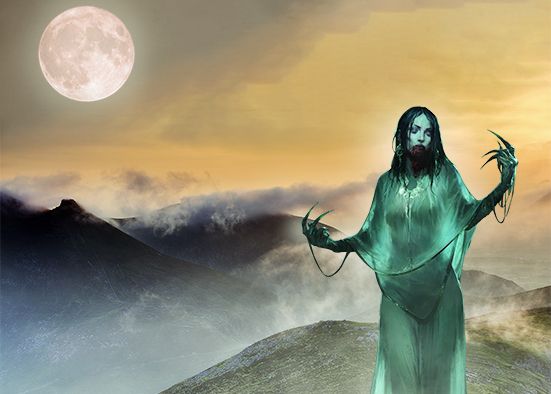Spookery in the Mournes where banshees roam freely with haunting wails
Spookery in the Mournes where banshees roam freely with haunting wails
25 October 2023

HALLOWEEN is here again — or Samhain, if you subscribe to the traditional Celtic calendar.
Pronounced ‘sow-win’, Samhain celebrates our entry into the dark half of the year. It is also synonymous with the sinister and supernatural as
it is, supposedly, when the barriers with the spirit world are thinnest, prompting interaction with the Otherworld.
Despite their reputation for stunning scenery more than spookery, there is a touch of the macabre in our Mourne Mountains. One supernatural species is particularly common in Mourne folklore, especially at Samhain — fairies.
Forget the friendly sprite that hovers around enchanted woodlands — that’s Hollywood’s portrayal. Irish fairies are mischievous and even malicious, with folklorists alleging that a variety are found among the Mournes.
The Irish fairy is described as human-like but much smaller, around 3-4ft tall. Finely dressed in red and green clothes, some say they have an otherworldly aura, as if surrounded by mist.
These fairies live in the famed fairy forts, or raths, and around fairy trees. On Samhain, they undertake the ‘fairy migration’ and move from summer to winter homes.
Traditionally, it was believed that upsetting a fairy caused a bad crop, a medical ailment, or even a lack of churn in your butter. Farmers feared ‘fairy-riding’ — livestock paralysis thought to result from fairies mounting them. ‘Fairy wind’ — a sudden gust of wind causing disability or death — was also feared, and fairies had a reputation for abducting small children and hiding them in their forts.
To appease the ‘Good People’ — a nickname coined to convey respect — people would offer milk, honey, traybakes or fruit. They would shout in warning before throwing water out the door, to avoid soaking a fairy. The first glass of a new batch of poitín was kept for fairies and distillers would spill the first for them.
Mourne folklore is rich with stories about these fairies. In Tales of Mourne, Richard Rowley tells of a late farmer near Slieve Bearnagh who left his farm to a nephew. But the nephew had migrated to Pittsburgh, so the farm was sold to an Ards man, named Herron.
Soon after buying, Herron was walking his new fields with a neighbour. They stopped at a meadow below Bearnagh that had a stone rath, a fairy tree and a well. Herron said he would remove the rath to plough the field. But his neighbour warned him:
Cut the Fairy-thornYe’ll wish ye’d ne’er been born;Fill the Fairy-wellYe may ring the funeral bell.
Herron was dismissive. He moved the stones, cut the tree and filled the well, persevering despite injuring his farmhand and breaking his horse’s leg in doing so. When he returned home, his wife had disappeared. He asked locals if they’d seen her. Even the police helped search. But she was gone.
Local fingers pointed at the fairies so, eventually, Herron rebuilt the rath and made them offerings. His wife was released and they moved as far away as possible – to Pittsburgh, apparently.
Púca
The Púca also features in Mourne folklore and is closely associated with Samhain, with farmers leaving some of the harvest as an appeasement — branded ‘the Púca’s share’. A shapeshifter, it typically appears as a horse, raven or hare with jet-black fur and luminescent eyes. Púcas supposedly abduct humans and take them for a death-defying ride on their backs, although WB Yeats wrote that they target only those who are drunk.
In the Mournes, the col between Slieve Bearnagh and Slieve Meelmore is called Pollapúca Gap (meaning ‘Hole of the Fairies’). It is unknown if the púca is still there because legend has it that púcas stopped harassing people after Brian Boru, former High King of Ireland, rode one long enough to force the púca to surrender and agree to never assault any Irishman again, except for drunkards and criminals.
Banshee
The banshee, meaning ‘woman of the fairy’ is more sinister, appearing as a ghost-like woman in bloodstained clothes. When a banshee’s piercing shriek is heard, it supposedly announces an impending death. This is what happened to King James I of Scotland, who was approached in 1437 and foretold of his imminent murder.
The Mournes are said to have their own banshee, supposedly seen walking silently among the moorings and lobster pots at Newcastle Harbour — that is until she shrieks in the customary high-pitched wail.
Dullahan
The Dullahan is the most menacing fairy. A ghostly headless horseman riding a black stallion around rural areas, he holds his glowing head under his arm, like a lantern. Wherever the Dullahan stops, someone instantly dies.
The poet and journalist, WJ Fitzpatrick, who wrote extensively about the Mournes, claimed he encountered a Dullahan near Tollymore Forest:
“I seen the Dullahan myself, stopping on the brow of the hill between Bryansford and Moneyscalp late one evening, just as the sun was setting. It was completely headless but it held up its own head in its hand and I heard it call out a name.
“I put my hand across my ears in case the name was my own, so I couldn’t hear what it said. When I looked again, it was gone. But shortly afterwards, there was a bad car accident on that very hill and a young man was killed. It had been his name that the Dullahan was calling.”
Changelings
To this list, changelings can be added. They are lesser-known fairies said to be the deformed and abandoned children of fairies who swap bodies with human babies.
Alp-luachra
The Alp-luachra is another fairy, also called a ‘joint-eater’. If someone falls asleep beside the Shimna or any other stream, the Alp-luachra appears as a newt and crawls down their throat to feed in their stomach.
Douglas Hyde, Ireland’s WW2-era President, wrote about a farmer starving from an internal Alp-luachra. He was told to stuff himself with salted beef and lie, mouth open, beside a stream. Gripped by thirst, the Alp-luachra jumped back out into the water.
Selkies
Selkies are less sinister but still frightening. They are shape-shifters who live under the sea as seals, until they shed their skin and appear on land as beautiful women. Folklore portrays selkies appearing to meet men — and even marrying them — around Ballymartin and the Annalong coast, where Slieve Donard sweeps down to the sea.
These stories obviously spark a healthy dose of scepticism. Naysayers paint them as fanciful folklore, or quaint ways that past generations made sense of the incomprehensible. But with Samhain on the horizon, dismiss them at your own risk lest you some wrath from the rath.


